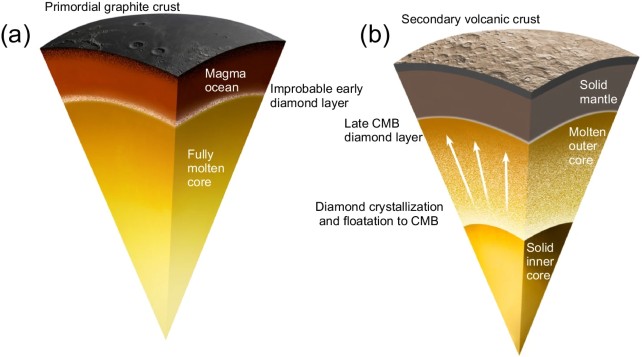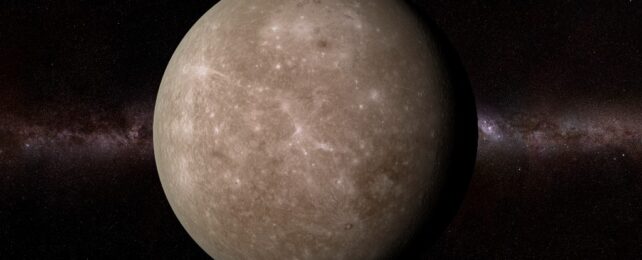Simulations of Mercury's childhood suggest the runt of the Solar System may have inherited a fortune in the form of a 15-kilometer (9-mile) thick layer of solid diamond.
Sandwiched between the core and the mantle hundreds of miles beneath the surface of a world that orbits within a whisker of our blazing hot Sun, the hypothetical bonanza is decidedly safe from any future spacefaring heists.
But the findings could have implications for the development of rocky planets like Mercury, and possibly explain a thing or two about the tiny planet's mysteriously persistent magnetic field.
A team of scientists from research institutes in China and Belgium were inspired by recent reassessments of Mercury's gravity field models to go back to the drawing board on the potential structuring of its internal environment.
Should the boundary between the core and the mantle turn out to be deeper than previously thought, the conditions for baking various materials out of its molten mineral soup would also need to be reconsidered.
Data from the recent MESSENGER missions has given astronomers the impression that the dark patches on Mercury's surface are mostly made up of carbon in the form of graphite, most likely coughed up from deep below rather than dusted from passing comets.
Running the numbers, sufficient quantities of carbon could have crystallized out of its magma at the boundary between the core and the mantle and floated up, contributing to the planet's crust as graphite.
Having so much graphite on the surface would imply Mercury was saturated with carbon, especially given how easily the element ought to be lost early in the planet's formation in the form of carbon dioxide and methane gasses.
Diamond is also a solid molecule made from carbon, of course, but has previously been ruled out as a possible product given insufficient pressures close to Mercury's core. Now, researchers think Mercury was possibly capable of giving its core a big ol' squeeze after all.
Using thermodynamic modeling to arrive at a deeper core-mantle boundary featuring greater pressures, the researchers behind this latest study designed experiments based on an approximation of Mercury's infant state as it slowly cooled under such extreme conditions.
It was in this revised Hell's Kitchen that the team found diamond could crystalize within the molten core and remain stable enough to rise towards the mantle with the graphite over eons, where it would collect in a layer estimated to be around 15 to 18 kilometers thick.

This was presuming a sulfur content of around 11 percent, and a pressure of roughly 1 to 2 percent of that found deep inside the Earth – both plausible given what we now know of Mercury's development.
With those assumptions in mind, taking the production of diamonds into account could influence models of Mercury's internal dynamics, especially considering the crystal's exceptional thermal conductivity.
The way heat rises from the core not only affects predictions on planetary cooling, and the evolution of other rocky worlds like it, but the movement of materials responsible for the generation of magnetic fields.
In spite of its comparably tiny size, Mercury is the only rocky planet other than our own to harbor a magnetosphere. What's more, though significantly weaker than Earth's, this magnetic field could be far older.
Understanding why Mercury's magnetic bubble has persisted for so long could require rethinking what lies deep beneath its skin.
This research was published in Nature Communications.
